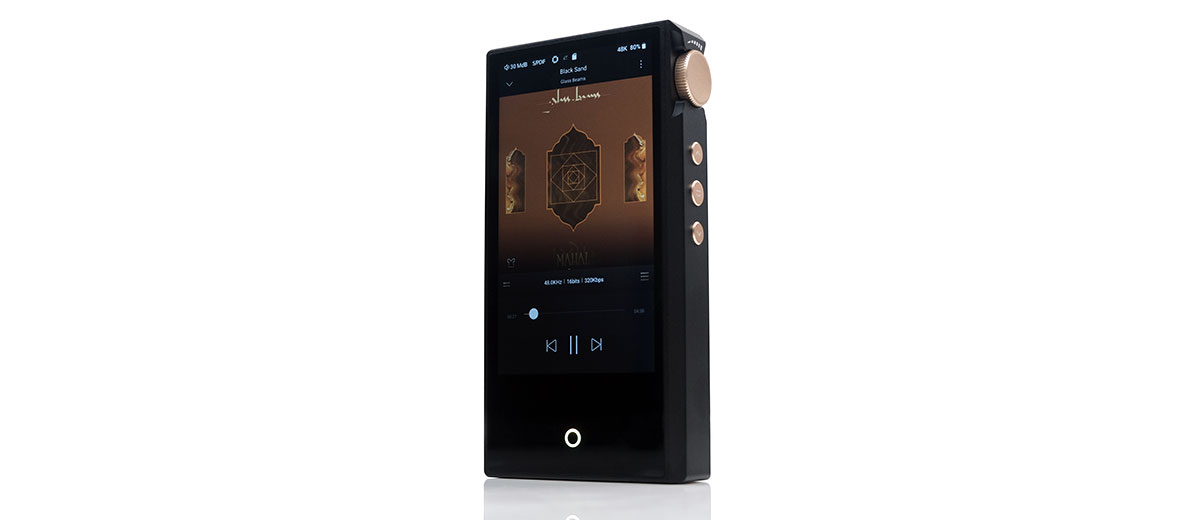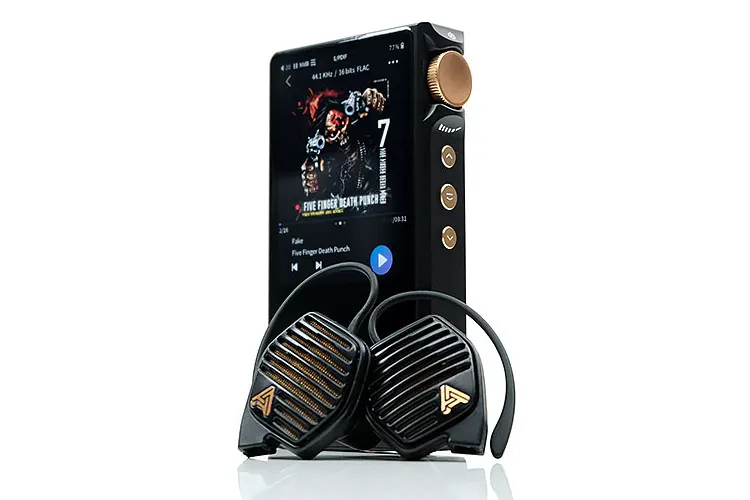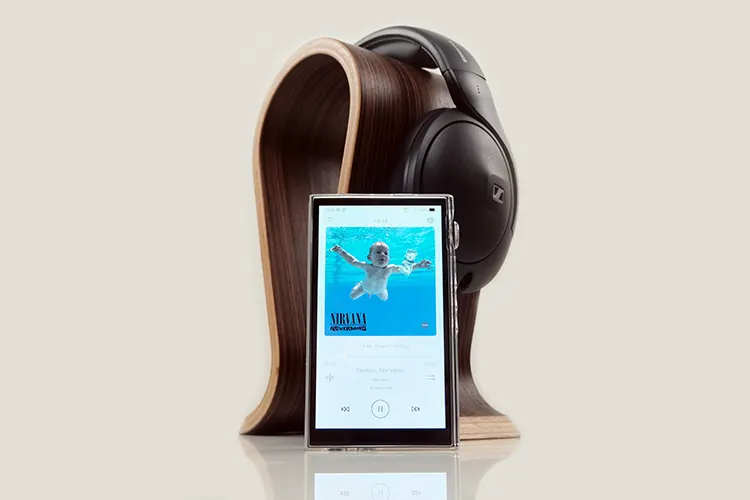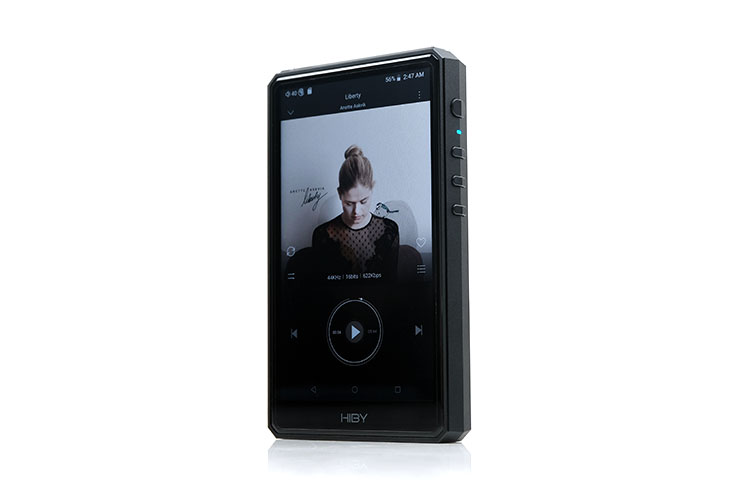Selected Comparisons
The following comparisons to the N3Ultra were completed using a mix of the Campfire Audio Fathom, the Sennheiser IE 600, and the FIR Audio’s e12. All connections were from the 4.4mm balanced output using stock cables except when comparing the N3Pro tube modes which were done via a 3.5mm SE connection.
Cayin N3Pro
The Cayin N3Pro was launched in 2021 at $479 SRP with our review published shortly after. It marked the debut of the first-ever tube-based digital audio player.
Technical
The basic premise here is the same, both are tube-implemented portable digital audio players.
However, where the N3Pro was a product of the company’s thinking from the N8 downwards, the N3Ultra incorporates a more expansive concept for portable tube players going down from the N30 LE.
For example, the miniature tubes that are connected as a buffer in N3Pro, are repositioned as a very low gain voltage amplifier in the N3Ultra.
That means switching from an older dual AKM AK4493EQ DAC to a newer AK4494S and local playback decoding being lifted from DSD256 (Native) and PCM 32BIT/384kHz to PCM 32BIT/768kHZ and native DSD512. USB Audio output for both is still the same at 32BIT/768kHz PCM and DSD512.
We also have a more powerful CPU, (Snapdragon 425 instead of Mips-based 1GHz SoC) with a modern and slicker Android 8.1 customized OS. Granted, it’s not an open OS, and there are no streaming options on the N3Ultra whereas the N3Pro did at least offer BT and wireless OTA.
There are some pros and cons when looking at the output power differences. At a high level, the N3Pro has more output power at 800mW on a balanced 32Ω load compared to 600mW from the N3Ultra.
However, on the N3Pro you can only use the solid-state timbre output on the 4.4mm output meaning the maximum rating for tubes is just 130mW from the SE side on a 32Ω load.
You can use tubes in balanced and unbalanced modes from the N3Ultra giving you a much higher 600mW capability for a similar load.
More than that, the new N3Ultra circuit path also means you can choose a tube timbre for all analog outputs including a balanced line-out, a feature not available on the N3Pro.
Design
Both units have a similar hand-friendly design language. However, due to the new ‘hanging’ tube implementation combined with the larger 4.1″ IPS panel, the N3Ultra has a physically larger form factor. Surprisingly, for the additional dimensions the weight increase is minimal at just 9g more.
Chassis design changes are more nuanced than overt except for the tube LED’s now emitting from the left side panel rather than under the screen on the front panel. It is more dramatic looking on the N3Ultra and more in line with the Korg Nutube lighting effect on the N8ii’s panel.
The subtle changes include the intricate chamfering around the top panel, moving power and screen on/off to the top panel, and keeping the rotary dial as a pure volume controller.
Aside from that the I/O and button control positioning or more or less unchanged with playback on the right panel, a single external memory card slot on the left, and both digital and analog PO/Lo on the base panel.
As a consequence of the slightly wider chassis dimension, there is a slightly better level of spacing between the sockets on the N3Ultra.
The user experience from the superior 4.1″ screen combined with Android is where I think most will find the most long-term impact. Scrolling is smoother, long media lists are more easily accessible, and the navigation is more intuitive on the N3Ultra compared to the smaller HiBy OS screen of the N3Pro.
Classic & Triode Performance
The Classic Mode is technically a re-tuned Triode mode from the N3Pro. Combined with the improved DAC output the N3Ultra Classic timbre mode is a big step up in performance.
I was never a huge fan of the N3Pro’s Triode mode, preferring to opt for the more expansive and airier Ultralinear alternative.
Ironically, that is exactly what the N3Ultra Classic timbre mode has brought; a stronger sense of space with much better separation, improved treble extension and presence, and better width and depth.
There is a bit more sparkle from the N3Ultra Classic Timbre so the tonal quality is a little brighter, with a slight sheen over midrange instrument and vocal notes. It offers more contrast and is not as rounded as the N3Pro triode timbre.
It is also much less mid-centric, or at least that is what the N3Pro Triode mode sounds like with a comparatively compressed vocal-first presentation and a truncated response from both sides of the FR.
Modern & Ultralinear Performance
It was a surprisingly similar story for the Modern Timbre mode versus the older Ultralinear mode. The N3Pro version sounds more intimate, less airy, and slightly truncated on the extreme ends of the FR, creating more of a mid-centric vocal first presentation.
The N3Ultra version improves on the upper treble extension, drops the forwardness of the upper mids a little, and introduces a slightly leaner note weight with a bit more sparkle and sheen creating a sweeter tone.
Low-end notes have improved depth and layering with staging pushing out wider and creating a more 3-dimensional performance.
Solid State Performance
I also found the patterns repeated for their two solid-state modes using the 4.4m balanced output and the Fathom/e12 pairings.
The N3Pro sounds flatter and less 3-dimensional, with an attenuated upper treble extension and a rounded midrange with intimate vocal imaging.
The N3Ultra version boasts superior separation, better height and air, and a slightly lighter midrange tonal weight with a bit more sparkle in its overtones. Vocal imaging is comparatively neutral helping to add to the perception of improved space.
iBasso DX180
The iBasso DX180 was launched a few weeks ago and for some users, its close pricing point and modern Android feature set represent one of the N3Ultra’s main competitors.
Technical
Just about the only thing these two DAPs share is that they are both bitperfect portable media players geared for IEM and headphone users. Aside from that they present two very different perspectives that could arguably be described as complementary.
The DX180 is an open Android 13 platform, powered by a higher-grade Snapdragon 625 and 4GB of RAM which is about right for that level of OS. If you want app scalability, streaming, and a portal to the outside world, this is the right choice.
The N3Ultra’s Android 8.1 is customized, so there is no app expansion capability nor does it need to manage a wireless side so a Snapdragon 425 Soc and 2GB of RAM is all it needs to create the same impression of speed. This is a pure player.
The N3ULTRA has a single external memory card slot and USB-OTG flash expansion with no onboard storage compared to 128 GB inside the DX180.
On the decoding and output side, things are more aligned. The N3ULTRA uses a dual AK4493SEQ DAC capable of matching the DX180 for local decoding up to DSD512 and PCM 32BIT/768kHz. Both devices can bypass SRC for bitperfect playback.
At up to 600mW from its Raytheon JAN6418 or solid-state balanced output, the N3ULTRA also comes close to the DX180 690mW performance. Both should be more than capable of driving similar types of headphones and IEMs.
Design
The N3ULTRA is as tall and deep as the DX180 and weighs almost the same at 204g compared to 206g. However, it is significantly narrower with a smaller 4.1” 720p TFT touchscreen which doesn’t have the same visual pop or borderless bezel design as the 1080p 5″ screen of the DX180.
I suspect one of the benefits of not being tied to an open Android system is being able to craft a device that does not need a huge LCD screen for flexible app compatibility. It does feel easier to operate single-handed than the DX180 and the volume dial has a smoother ‘clicky’ action.
The N3ULTRA’s user experience is slick enough and easy to understand. The silent hand of HiBy with its HiByMusic skin on top of Android and many audio settings that mirror that of HiByMusic such as Exclusive HQ USB audio access mode gives it a familiar feel.
The DX180 full Android experience opens up more user customization potential with different themes and a wider range of app choices making it a much more scalable and personal user experience.
Its superior 13-15 hour playback time will take a hit though the more you use wireless or load the DX180 with intensive apps.
All the I/O on the N3ULTRA is at the base. It has a dedicated single-ended LO and PO with dual functional balanced PO/LO whereas the DX180 has dual functionality for 3.5mm and 4.4mm hence just 2 ports. Coaxial is handled via USB-C on the Cayin and the 3.5mm PO on the DX180.
Cayin has done away with the multifunction aspect of the N3ULTRA dial with a power/screen switch on the top panel a feature which is retained on the DX180.
Performance
In the battle of the solid states, the DX180 shows a bit more dynamic range, with a high-energy approach. The N3ULTRA alternative is more relaxed and intimate, with slightly more warmth in the lows, and not as ‘driven’ sounding as the DX180.
Mind you, I am not 100% sure people will buy the N3ULTRA for a solid-state mode, it’s more about the tube sound which is where the major differences will come through.
The Classic timbre mode is a bit deeper-sounding than the DX180, fuller on the sub-bass but with a more languid mid-bass punch. This effect is more evident with the IE 600’s dynamic driver compared to the Fathom’s lighter BA driver.
There is a distinct hall-like or atmospheric quality to the N3ULTRA Classic soundstage, particularly through the mids where vocal imaging is marginally more relaxed in its positioning relative to the DX180’s more upfront midrange focus.
The modern timbre mode sits somewhere in between Classic and solid-state modes with more of a driven firmer mid-bass tone and slightly more presence in the highs to go along with it.
Of the three modes, it comes closer to the urgency of the DX180 lows but some longer decay trails and a slightly sweeter sparkling overtone in the upper-mids give away its tube traits.
HiBy R5 Gen 2
The HiBy R5 Gen 2 was launched in mid-2022 with our review published shortly after. It is slightly cheaper than the N3Ultra though some Cayin DAPs, it offers multiple operating modes.
Technical
Both DAPs are compact bitperfect Android 8.1 platforms with 2GB of RAM and a Snapdragon 425 SoC as their respective CPU. The key difference here is the open nature of the R5 Gen’2 Android OS whereas the N3Ultra is heavily customized.
That means you can scale the R5 Gen 2 with apps from the Google Play Store though the slower CPU and RAM levels will make it less likely to perform as well as the Android 13/4GB of RAM DX180. It also has more wireless connectivity options with the inclusion of WiFi and BT.
The N3Ultra’s lack of app scaling or wireless connectivity might put off some potential users but the payoff is the speed and user experience, which will stay consistent throughout its lifecycle.
Both DAPs are delta-sigma, the R5 Gen 2 is equipped with a dual ES9219C implementation as opposed to a newer AK4493SEQ. Decoding is on par at PCM 32BIT/768kHz maximum but slightly behind for DSD at DSD256 rather than DSD512 for the R5 Gen 2.
Modes are the name of the game for both DAP amplifiers. The N3Ultra focuses on solid-state and tube timbre modes and the R5 Gen 2 is all solid-state with an operational mode switch between a Class A discreet resistor-based push/pull design and a throwaway SoC-driven circuit that is more about saving battery life.
At max output, the R5 Gen 2 Class A mode is weaker than the N3Ultra at 475mW into a 32Ω load going balanced compared to 600mW making the Cayin unit a bit more flexible for more demanding headphones.
Design
Both DAPs are relatively pocketable and easy to operate single-handed though the experience is quite different.
The N3Ultra is taller and deeper, but narrower with that rotary dial on the right panel making it easier to operate for volume in one hand. The R5 Gen 2 places digital volume buttons on the left panel which, while still relatively accessible, can sometimes require both hands for rapid volume changes.
Most of the I/O is similarly positioned on the base panel though a 2.5mm socket for a balanced LO option on the R5 Gen 2 is showing its age a bit. Both devices have a single microSD slot with the R5 Gen 2’s small 16GB allotment of onboard memory still more than the 0GB from the N3Ultra.
The wider screen on the R5 Gen 2 is more dictated by the need to provide a suitable screen size for Android app compatibility.
However, I would say the N3Ultra has the edge in the user experience. Less background services and task loads from that truncated OS version seem to make it a bit snappier for media management and navigation.
The main benefit of the R5 Gen 2 OS layer is the greater level of UI customization and I include the drop-down screen in that description since you can edit it to some degree.
The battery performance is similar if you stay on the R5 Gen 2’s Class A mode but all bets are off with the HiBy eco-mode 35-hour cycle. Hard to justify it though considering the drop in audible sound quality.
You can get up to almost 12 hours going SE on the N3Ultra’s solid-state output but it will drop as low as 7 hours going balanced on its Classic tube output.
Performance
I always felt the R5 Gen 2 Class A mode had one of the beefiest low-ends from a mid-fi DAP. Not anymore.
Ranged against the N3Ultra Classic and Modern tube mode, the Cayin tuning has a much more pronounced bass shelf with superior depth and weight from the IE 600 and the e12. Now, that can work for and against.
With the IE 600, I appreciated the additional definition and body as the R5 Gen 2 sounded flatter sub-100Hz. However, with the e12 I felt the bass might be somewhat overcooked relative to the rest of the range.
Why overcooked? With both IEMs, the N3Ultra mids and highs sound leaner with more sparkle in the Modern mode compared to the mellower R5 Gen 2. Arguably, the R5 Gen 2 Class A mode might have a better tonal balance over the N3Ultra Modern mode when using bass-heavy dynamic driver IEMs.
I would still say that the technical edge lies with the N3Ultra Classic and Modern Modes. You get a stronger perception of notes clarity and more holographic imaging whereas it is a slightly more blended sound and less well separated on the R5 Gen 2.
For solid-state mode versus Class A mode going balanced, I am hearing a similar FR emphasis from the IE 600 only with a slightly tighter more energetic pace, and a reduced soundstage.
The N3Ultra still offers a heightened bass shelf and more relaxed vocal imaging. It also has a lighter note quality with more contrast from an enhanced upper treble extension.
The R5 Gen 2 is noticeably more vocal forward with the IE 600, a little flatter on the bass but slightly warmer through the mids courtesy of a more attenuated set of highs.
My Verdict
The Cayin N3Ultra DAP is a huge step up from the older 2021 N3Pro version. It offers a faster, slicker OS, improved technical capability from an updated DAC, and re-tuned timbre modes that make the original versions sound comparatively flat and compressed.
Of course, as a pure player, it’s not for everyone. There is no wireless connectivity or Android app expansion capability which is a staple on most DAPs at this price point. If you need that there are other choices at similar prices.
The N3Ultra is going its own way and knows its target audience. It is an altogether more enjoyable experience than what has come before in that regard.
The most surprising aspect is just how much fun the low-end is from the tube modes. I was not expecting the N3Ultra to carve itself out as a potential bass king at this price point but here it is.
Cayin N3Ultra Technical Specifications
- Proprietary Gen3 Tube Circuit.
- Military Grade NOS Vaccum Tube.
- Classic, Modern, Solid-State Triple Timbre.
- Dual AK4493S DAC Chips.
- Snapdragon 425 SoC Chipset.
- Supports 32-bit/768kHz PCM and Native DSD512 Decoding.
- Dual Femtosecond Ultra-Low Jitter Oscillators.
- 4-Ch JRC Electronic Volume Control.
- Fully Customizable 10-Band Parametric EQ.
- 3.5mm+4.4mm Headphone and Line-Out Options.
- Digital USB Output.
- Hi-Res USB DAC Functionality.
- 4.1” TFT Display Screen.
- 4500mAH High-Capcity Battery.
- QC3.0 Fast Charging Support.
- Upto 10 Hr Battery life.





